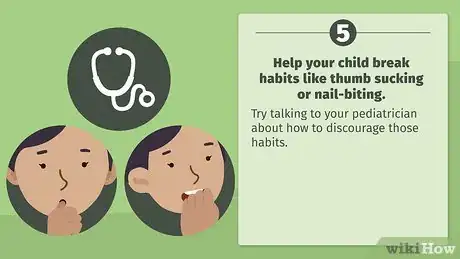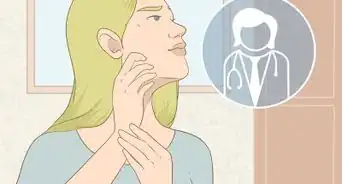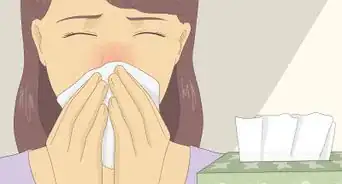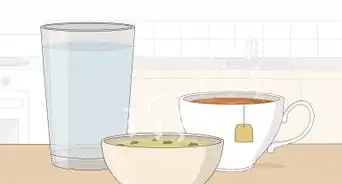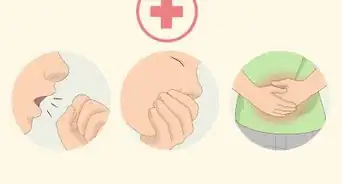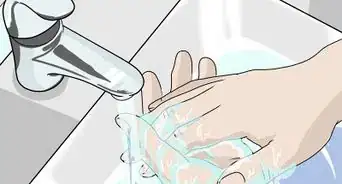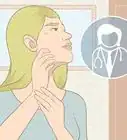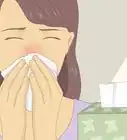This article was co-authored by wikiHow staff writer, Amy Bobinger. Amy Bobinger has been a writer and editor at wikiHow since 2017. She especially enjoys writing articles that help people overcome interpersonal hurdles but frequently covers a variety of subjects, including health and wellness, spirituality, gardening, and more. Amy graduated with a B.A. in English Lit from Mississippi College in 2011 and now lives in her hometown with her husband and two young sons.
There are 7 references cited in this article, which can be found at the bottom of the page.
This article has been viewed 31,804 times.
Learn more...
Kids seem like they're constantly touching everything in their environment, from tables and chairs to doorknobs and stair-rails. Since those surfaces may hold germs, you can help your child avoid illness by encouraging them not to touch their face throughout the day. Getting your child to stop touching their face can seem impossible, but if you keep a close eye on your child and pair it with other strategies for keeping your family healthy, you may be able to help them break the habit and avoid getting sick!
Steps
Discouraging Face-Touching
-
1Explain why it's important if your child is old enough. Once your child is about 3 years old, you can begin having conversations with them about avoiding germs, including the importance of washing their hands and how touching their face can spread germs to their nose and mouth. While just knowing this information probably won't help them break the habit, it can help set the groundwork, so they'll understand when you remind them later on.[1]
- For instance, you might say something like, "If you touch something with germs on it, then touch your face, you can get really sick. That's why it's important to wash your hands, but it's important to keep your hands away from your face, too."
- You might also include something along the lines of, "I know it can be really hard to remember sometimes. I forget, too! Maybe we can help each other remember not to touch our faces."
-
2Remind your child any time you see them touching their face. While you don't want to criticize your child or put them down when they forget, it is important to point out when you see them with their hands around their face or mouth. Sometimes, just becoming aware that they're doing it will be enough to help them stop doing it.[2]
- Including a special nickname in your reminder may help your child feel like you're on their team. For example, you could gently say, "Hands off your face, buddy!" or "Don't chew your nails, pumpkin!"
Advertisement -
3Praise your child when you notice that they aren't touching their face. It can be hard to remember sometimes, but look for opportunities to let your child know when they're doing a good job of keeping their hands away from their face. Positive reinforcement can be a really powerful motivation for kids to keep trying when they're learning something new.[3]
- You can use encouraging words or even offer small treats or stickers as a reward. For instance, you might say something like, "I noticed you were doing a really great job not chewing your nails today. You get a sticker on your behavior chart!"
-
4Offer your child something they can hold or do with their hands. Children often touch their face or mouth without thinking about it. Many times, it's just because they're bored and they're looking for a way to stimulate themselves. If you think that might be the case, try giving your child a toy they can hold onto, like an action figure with movable parts or a fidget toy.[4]
- Putty and slime can be good toys for keeping your child's hands engaged, as well.
- If you have a smaller child, keep an eye on them to make sure they don't put the toy into their mouth since they could pick up germs that way.
Tip: Encourage safe and healthy fidgeting in kids who are naturally fidgety or who have disabilities like autism and ADHD. Fidget toys and fidget jewelry provide easy options to redirect their extra energy. For example, if your autistic child is scratching their face, you can say "What do we use to fidget?"
-
5Help your child break habits like thumb sucking or nail-biting. While simple reminders may be enough to stop your child from casually touching their face, it can be a lot harder if they have an ingrained habit like biting their nails or sucking their thumb or fingers. If that's the case, try talking to your pediatrician about how to discourage those habits, like using a bitter-tasting substance on their nails, so they won't want to put them in their mouth.[5]
- It may also help to give your child something to distract them. For instance, you might offer them a crunchy snack like granola, a piece of bubble gum, or a drink with a straw.[6]
- Don't criticize or shame your child for habits like nail-biting or thumb sucking, as that can actually make the problem worse.
Taking Other Steps to Avoid Illness
-
1Sanitize surfaces that your family touches regularly. Use a disinfectant spray or antibacterial wipes to clean your countertops, doorknobs, light switches, toilet handles, and any other objects that people might touch.[7] That way, if someone did have germs on their hand, they won't be transferred to the next person who comes by and touches that surface.
- Use alcohol wipes to disinfect your phones, tablets, and other electronic devices.
-
2Teach your child to wash their hands frequently. Supervise your child when they wash their hands to ensure they're using soap and water to wash their hands for at least 15-20 seconds. As they wash, make sure they wash the backs of their hands, their palms, in between their fingers, and under their fingernails.[8]
- Your child should wash their hands before they eat or help prepare food, after using the restroom, after they cough or sneeze, and any time their hands get dirty.
- Use an alcohol-based hand sanitizer to cleanse your child's hands if they need to wash but aren't around a sink or soap.
-
3Show your child how to sneeze into their elbow. Tell your child that when they need to sneeze, they should hold their arm up across their face and turn their head, so they sneeze into the crook of their arm. This can help keep their germs from flying across the room or getting on their hands.
- If your child sneezes into their hands, they could then spread germs by touching surfaces in your home.
- Remind your child that if they wipe their nose or sneeze into a tissue, they should throw the tissue into the trash right away to avoid spreading germs.[9]
Tip: Remember to model this behavior when you sneeze, as well. Setting a good example is one of the best ways to encourage a child to do something!
-
4Help your child get plenty of sleep. Getting a good night's sleep is essential for a child's developing immune system. Try to keep a regular bedtime and waking time for your child, even on the weekends. Make sure their room is cool, dark, and comfortable at night, and keep your home as quiet as possible, so your child can sleep well.[10]
- Between the ages of 1 and 2, children need 11-14 hours of sleep a night, including naps.
- Between 3 and 5, kids need 10-13 hours a night, including naps.
- From the ages of 6 to 12, your child needs 9-12 hours of sleep each night, and they probably will not take a nap.
- Teens who are 13-18 years old need about 8-10 hours of sleep every night.
-
5Make sure your child eats a healthy diet rich in fruits and veggies. It can be hard to get kids to eat healthy food, but try to make it more fun for them by allowing them to help you choose and prepare healthy meals for the whole family. For example, you might work together to make a colorful tossed salad, then serve that alongside grilled chicken and a whole grain roll.[11]
- Choose healthy snacks like apples, carrot sticks, and whole-grain toast with peanut butter rather than processed foods high in carbs and sugar.
- The nutrients found in whole, healthy foods can help strengthen your child's immune system, helping them fight off germs they may come into contact with.
- If you're concerned your child isn't getting enough fruits and vegetables in their diet, ask your pediatrician if they should take a daily multivitamin.
References
- ↑ https://www.ucihealth.org/blog/2018/12/cold-flu-prevention
- ↑ https://www.caringforkids.cps.ca/handouts/common_infections_and_your_child
- ↑ https://raisingchildren.net.au/toddlers/behaviour/common-concerns/habits
- ↑ Shaun Berger, MD. Pediatrician. Personal interview. 17 April 2020.
- ↑ https://raisingchildren.net.au/toddlers/behaviour/common-concerns/habits
- ↑ https://pathways.org/child-chew-everything-3-common-questions-parents-ask/
- ↑ Shaun Berger, MD. Pediatrician. Personal interview. 17 April 2020.
- ↑ https://www.ucihealth.org/blog/2018/12/cold-flu-prevention
- ↑ https://www.caringforkids.cps.ca/handouts/common_infections_and_your_child
About This Article
Kids are constantly touching the world around them, which is a normal part of how they learn and grow. Unfortunately, if they then touch their face, they might introduce germs or viruses into their nose, mouth, or eyes. If your child is old enough to understand, explain that touching their face a lot could make them sick. You can also gently remind them to take their hands off their face any time you notice them touching it. Offer them something else to do with their hands, like playing with blocks or a fidget spinner. Since you can’t completely prevent face touching, make sure your child washes their hands often with soap and water so they don’t introduce a lot of germs. For more tips, like how to work with your child’s doctor to manage habits like thumb sucking, keep reading!




